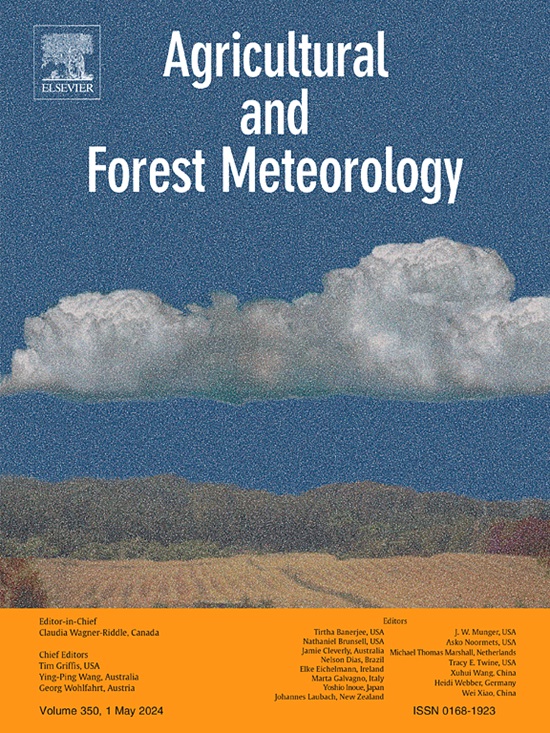Temperature-driven shifts in spatiotemporal stability of climate-growth responses of Douglas-fir (Pseudotsuga menziesii) from the southern Baltic Sea region
IF 5.6
1区 农林科学
Q1 AGRONOMY
引用次数: 0
Abstract
The southern Baltic region spans a significant part of the European continent with its forests under significant pressure due to climate changes. The implications of these changes are crucial for both native and non-native tree species. Under future climate scenarios, most native conifer populations might lose their climatic optima in the region. In contrast, for non-native Douglas-fir (Pseudotsuga menziesii (Mirb.) Franco), climatic conditions are expected to become optimal in the Baltic Sea region. Therefore, understanding the acclimatisation trajectory of Douglas-fir over the last century is essential to assess its potential to supplement retreating species and reduce pressure on local habitats. To study the region-wide acclimatisation in the secondary distribution, we established a network of 27 Douglas-fir tree-ring chronologies along the south Baltic Sea. We determined the spatio-temporal stability of the climate signal in tree rings and the potential coastal effect on the plasticity of the growth response. We found a region-wide trend of climate-growth relationships, with a dominant effect of the early-growth season temperatures being more pronounced for mature than young stands. Sites with higher mean annual temperatures exhibit a stronger positive temperature–growth correlation, demonstrating the sensitivity of Douglas-fir to climate warming. Douglas-fir could serve as a more heat-tolerant alternative to the declining European species of the Pinaceae family and contribute to the preservation of functionally comparable coniferous forest communities. However, forest practitioners should be aware that Douglas-fir may alter habitat conditions affecting microclimate and influencing species diversity.

波罗的海南部地区道格拉斯冷杉气候生长响应时空稳定性的温度驱动变化
波罗的海南部地区横跨欧洲大陆的很大一部分,其森林因气候变化而面临巨大压力。这些变化的含义对本地和非本地树种都至关重要。在未来的气候情景下,该地区大多数本土针叶树种群可能会失去其最佳气候条件。相比之下,对于非本地道格拉斯冷杉(pseudosuga menziesii (Mirb.))佛朗哥),波罗的海地区的气候条件预计将成为最佳。因此,了解道格拉斯冷杉在过去一个世纪的适应轨迹,对于评估其补充退缩物种和减少对当地栖息地的压力的潜力至关重要。为了研究次生分布的区域适应性,我们沿南波罗的海建立了27个道格拉斯冷杉年轮年代学网络。我们确定了树木年轮中气候信号的时空稳定性,以及沿海对生长响应可塑性的潜在影响。研究发现,气候-生长关系在区域范围内具有明显的变化趋势,成熟林分生长季前期温度的主导作用比幼林更明显。年平均气温较高的样地表现出较强的正相关关系,表明道格拉斯冷杉对气候变暖的敏感性。道格拉斯冷杉可以作为一个更耐热的替代品,以减少松科的欧洲物种,并有助于保存功能相当的针叶林群落。然而,森林从业者应该意识到道格拉斯冷杉可能改变栖息地条件,影响小气候和物种多样性。
本文章由计算机程序翻译,如有差异,请以英文原文为准。
求助全文
约1分钟内获得全文
求助全文
来源期刊
CiteScore
10.30
自引率
9.70%
发文量
415
审稿时长
69 days
期刊介绍:
Agricultural and Forest Meteorology is an international journal for the publication of original articles and reviews on the inter-relationship between meteorology, agriculture, forestry, and natural ecosystems. Emphasis is on basic and applied scientific research relevant to practical problems in the field of plant and soil sciences, ecology and biogeochemistry as affected by weather as well as climate variability and change. Theoretical models should be tested against experimental data. Articles must appeal to an international audience. Special issues devoted to single topics are also published.
Typical topics include canopy micrometeorology (e.g. canopy radiation transfer, turbulence near the ground, evapotranspiration, energy balance, fluxes of trace gases), micrometeorological instrumentation (e.g., sensors for trace gases, flux measurement instruments, radiation measurement techniques), aerobiology (e.g. the dispersion of pollen, spores, insects and pesticides), biometeorology (e.g. the effect of weather and climate on plant distribution, crop yield, water-use efficiency, and plant phenology), forest-fire/weather interactions, and feedbacks from vegetation to weather and the climate system.

 求助内容:
求助内容: 应助结果提醒方式:
应助结果提醒方式:


